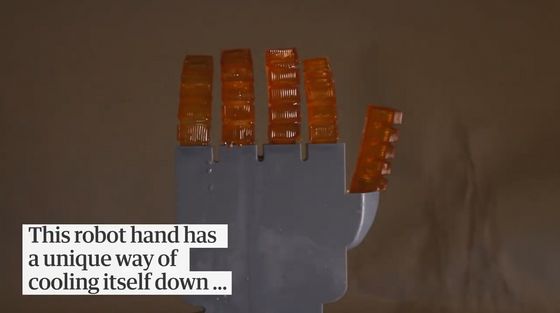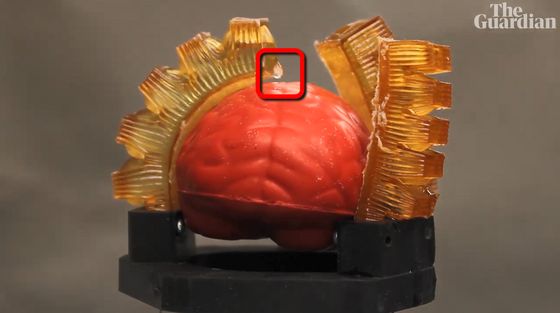A robot that sweats like a human being is developed, achieving three times the cooling efficiency of humans

Mammals secrete sweat from the sweat glands of the skin and use the cooling effect of the heat of vaporization during evaporation to maintain proper body temperature. A robot hand equipped with such a 'sweat' function to prevent overheating and maintain performance has been developed.
Autonomic perspiration in 3D-printed hydrogel actuators | Science Robotics
Scientists build robot hand that can sweat | Technology | The Guardian
https://www.theguardian.com/technology/2020/jan/29/scientists-build-robot-hand-that-can-sweat
Robots learn to sweat to stop overheating-The Verge
https://www.theverge.com/2020/1/29/21113421/soft-robot-hands-sweat-overheating-research

Like living organisms, robots can lose their performance due to overheating, and developing an efficient cooling system is important for improving the performance of robots. A research team at
'Often, biology has provided us with a great guide as an engineer. The ability to sweat is one of the most prominent features of humans,' said Thomas Wallin of the research team. Is a comment. Mr Wallin points out that humans were not the fastest animals on land but succeeded as predators because they were able to moderately sweat and regulate their body temperature and keep pursuing their prey for a long time. I am.
For some time, robots and computer cooling systems circulated liquids through closed tubes inside the machine, but the research team adopted a 'naturaler solution' to address the overheating problem. The inside of the developed robot hand is filled with water and connected to a surface with a plastic hole that reacts to heat. Normally, water does not flow out of the robot hand because the hole is closed, but when the plastic forming the hole reaches a specific temperature, a hole is opened and water flows out of the surface of the robot hand.
You can see how the robot actually sweats in the following movie.
This robot hand can 'sweat' to cool itself down-YouTube
The robot hand developed by the research team consists of five human-like fingers made by 3D printing.

You can see the water dripping from the bent fingertips. In this robot hand, the water inside also plays a role as a power source like hydraulic oil.

The fingers of the robotic hand are made of a

When the robot hand reaches a certain temperature, a hole in the finger is opened and water flows out.

If you actually hold a hemispherical object ...

Water came out of my fingertips. The surface of the finger has a large surface area to enhance the cooling effect of sweat, and in an environment where there is wind from a fan, cooling efficiency has been achieved as much as 600% compared to a robot hand that does not sweat. This sweating efficiency was more than three times higher than that of humans and horses, which have high cooling efficiency due to sweat among mammals.

'The best part of this strategy is that the thermal control performance is based on the material itself. It does not require sensors or other components to control the sweating of the robotic hand,' Wallin says. . Through additional experiments, it has been confirmed that sweat flowing out of the robot hand also cools the object itself.
In metal robots, heat is easily dissipated because metal itself is an excellent conductor. On the other hand, robots used for delicate tasks, such as medical procedures and packing fresh food, are often made of rubber, a good insulator. It is said that there is a merit in the cooling function by sweating in the cooling of the soft robot that does not allow such heat to escape. In addition, by incorporating the sweat glands into the robot, it is possible to cool the sweat glands below the ambient temperature.
One of the drawbacks of sweating robots is that they need to regularly replenish the water they emit as sweat. The biggest problem is that sweat will lubricate the fingers of the robot hand, reducing friction and making it difficult to grasp objects. The research team stated that this problem could be solved by adding a grip to the fingertip.
Related Posts:







